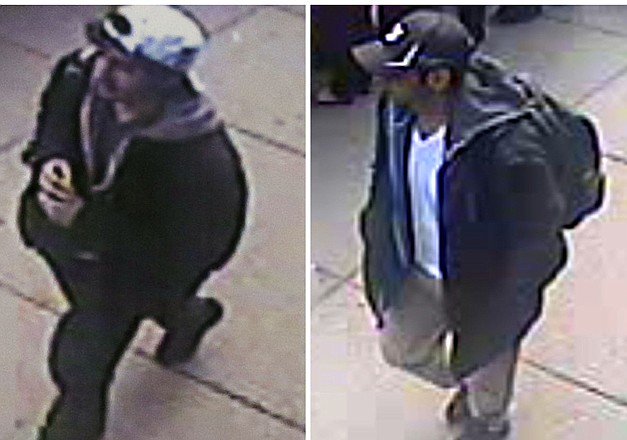BOSTON (AP) - Plucking a couple of blurry faces in baseball caps out of a swarming crowd, the FBI zeroed in on two suspects in the Boston Marathon bombing and shared surveillance-camera images of them with the world Thursday in hopes the public will help hunt them down.
The photos and video depict one young man in a dark cap and another in a white cap worn backward, both carrying backpacks and one walking behind the other on the sidewalk near the finish line as marathoners run by.
The man in the white hat was seen setting down a backpack at the site of the second explosion, said Richard DesLauriers, FBI agent in charge in Boston.
"Somebody out there knows these individuals as friends, neighbors, co-workers or family members of the suspects," he said. "Though it may be difficult, the nation is counting on those with information to come forward and provide it to us."
They looked much like typical college students, but DesLauriers described them as armed and extremely dangerous, and urged anyone who sees or knows them to tell law enforcement and "do not take any action on your own."
The break in the investigation came just three days after the attack that killed three
people, tore off limbs and raised the specter of another terrorist attack on U.S. soil. FBI photo-analysis specialists have been analyzing a mountain of surveillance footage and amateur pictures and video for clues to who carried out the attack and why.
The volume of information is likely to grow, joined now by a torrent of tips from people who think they might know the suspects. In releasing the images, the FBI gambled that useful clues will emerge, not just time-wasting leads.
Authorities are selective in putting out images of suspects because doing so risks tipping off the hunted and losing the element of surprise. But it can be a last resort when authorities hit a wall trying to identify or capture someone.
Within moments of the announcement, the FBI website crashed, perhaps because of a crush of visitors.
The images were released hours after President Barack Obama and first lady Michelle Obama attended an interfaith service at a Roman Catholic cathedral in Boston to remember the dead and the more than 180 wounded in the twin blasts Monday at the finish line of the 26.2-mile race.
The FBI video is a compilation of segments, altogether about 30 seconds long. The planting of the backpack, as described by authorities, was not part of the footage made public.
The man in the dark hat was dubbed Suspect 1 and appeared to be wearing sunglasses. The other, in the white hat, was labeled Suspect 2. Both appeared to be wearing dark jackets. The FBI did not comment on the men's height, weight or age range and would not discuss their ethnicity.
"It would be inappropriate to comment on the ethnicity of the men because it could lead people down the wrong path potentially," said FBI agent Greg Comcowich, a spokesman for the Boston FBI office.
While authorities said the information on the men began coming together over the previous day or so, agent Daniel Curtin said the FBI did not release the photos earlier because "it's important to get it right."
Distribution of the images brought both encouragement and unease to some Bostonians.
Judy and Marc Ehrlich watched the marathon from a spot between miles 25 and 26 on Monday and felt the ground shake when the bombs exploded. The couple said it was creepy to see images of the suspects who were there at the same time, walking around. But they were comforted that the FBI had come up with suspects.
"Unless they kill themselves, they're going to get found," Marc Ehrlich said. He added: "There's nowhere in the world to hide."
At the Cathedral of the Holy Cross earlier in the day, Obama declared to the people of Boston: "Your resolve is the greatest rebuke to whoever committed this heinous act." He spoke in almost mocking terms of those who commit such violence.
"We finish the race, and we do that because of who we are," the president said to applause. "And that's what the perpetrators of such senseless violence - these small, stunted individuals who would destroy instead of build and think somehow that makes them important - that's what they don't understand."
"We will find you," he warned.
Seven victims remained in critical condition, but the death toll remains at three.
Video and photos recovered in the investigation are being examined and enhanced by an FBI unit called the Operational Technologies Division, said Joe DiZinno, former director of the FBI lab in Quantico, Va.
Investigators are looking at video frame by frame - a laborious process, though one aided by far more sophisticated facial recognition technology than is commercially available, forensic specialists said.
The investigation will probably collect about a million hours of videotape from fixed security cameras and cellphones and cameras used by spectators, said Gene Grindstaff, a scientist at Intergraph Corp., a Huntsville, Ala., company that makes video analysis software used by the FBI and other law enforcement agencies.
But after years of investigating terrorist incidents and other crimes, the FBI is practiced at cataloging, categorizing and analyzing such evidence and will winnow it down dramatically, he said.
"Back in the days of 20 years ago, you were lucky if you had video and it was probably of poor quality and it took a tremendous amount of enhancement. Today you have a completely different issue," Grindstaff said.
Investigators can set the video analysis software so that it automatically searches for certain types of objects or people matching a height and weight description. The software can also spot patterns that analysts might not notice, such as a certain car that turns up in different places, Grindstaff said.

